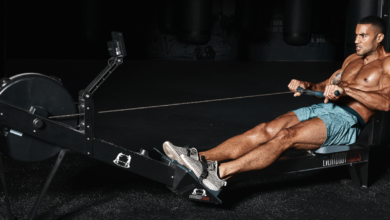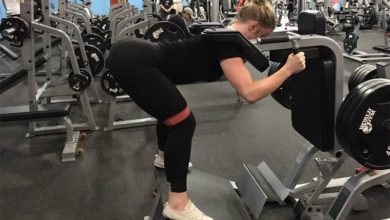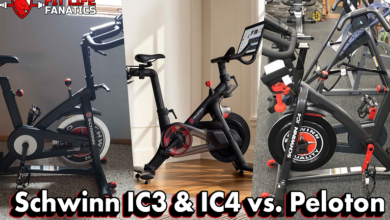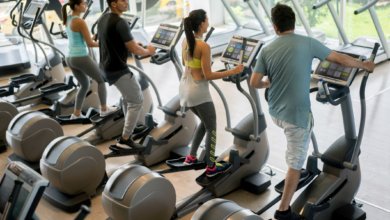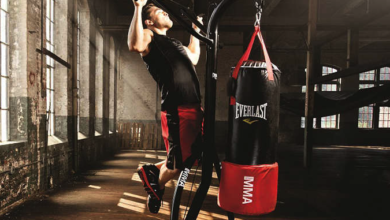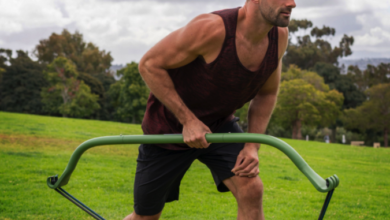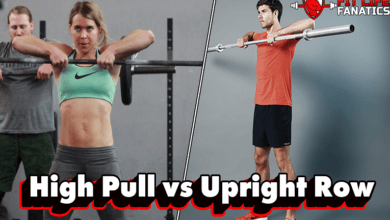Stamina vs Endurance – Differences, Types, Training Styles, and Exercises For Each

A lot of people talk about Stamina vs. Endurance without having the faintest idea of the differences between these two terms.
In fact, these terms are often thrown around interchangeably in terms of physical activity, whereas in reality, they are as distinct as chalk and cheese.
They are related, mind you. Just not the same.
So, what’s the difference between stamina and endurance?
Let’s find out.
Stamina, What Is It?

To be honest, there’s no universal definition for stamina.
But if one were to put it in words, Stamina can be defined as the maximum amount of time that a muscle, or a group of muscles can perform an activity at their maximum capacity.
Here’s a hypothetical example.
If you can perform a single deadlift of 500 lbs., while your friend can only deadlift 450 lbs., you clearly have better muscle strength than them.
But if they can perform 2 or more repetitions at 450 lbs., they have greater muscle stamina as their muscle groups are able to perform for extended period at maximum capacity.
The best example of someone who needs to develop stamina is a sprinter, who has to perform at max muscular and aerobic capacity for a specific duration of time.
You might have heard that running helps build muscle, but it’s also true that you need muscle stamina for runs.
What is Endurance?

Muscular endurance refers to the maximum amount of time that a muscle, or a group of muscles can perform or sustain physical activity.
Not necessarily at its max capacity though.
It is generally accepted though that endurance is measured against physical activity that increases your heart rate at least by 50%.
That said, even everyday lifestyle activities such as lifting heavy items, mopping the floor, using the dryer, stirring food and children playing around home, can be constituted as endurance.
That’s because it’s a single, or a muscle group performing repetitive tasks over the course of the day.
The idea behind endurance is to maximize time that the muscles work for, irrespective of the capacity at which it is performing.
Think of a long distance runner, who unlike a sprinter, will focus on covering the maximum distance in a specific time without emphasizing on speed.
Types of Endurance
There are different distinct components to endurance, although some of them overlap while others can possibly be broken down further into sub-categories.
Specific Endurance

Also called Muscle Endurance, it is described as the muscles ability of a specific group of muscles to perform against fatigue, and is usually used for sports training.
The better your muscle endurance or specific endurance, the better you can be at the specific sport.
For example, someone partaking in boxing sport will focus on a set of training techniques that help improve their specific endurance, to box without a dip in performance over the course of 10-12 rounds.
Similarly, a 1000m runner, will use an entirely different set of techniques altogether that allows them to amplify their performance over that distance.
Cardiopulmonary Endurance
Also called full-body endurance, cardiorespiratory endurance is defined as the ability of your heart to consistently supply enough oxygen to working muscles without getting fatigued.
This is where cardio machines like elliptical bikes, incline treadmills, stationary bikes and ellipticals come in.
Related Reading; The Best Shoes For The Stairmaster – Most Comfortable Sneaker Options
This bumps up your overall cardiorespiratory fitness, giving you more energy to undertake more intense workouts like weight lifting (such as squats or deadlifts) or running at maximum speed without running out of breath.
Training for improved endurance, coupled with aerobic activity, ensures your muscles achieve maximum oxygen uptake.
This helps improve your fitness level, overall stamina, and athletic performance in all disciplines of sport, along with a galore of other great overall health benefits.
For example, if you have great aerobic fitness and full-body endurance as an amateur boxer, you will also be able to perform reasonably well at the professional level, where the number of rounds you stay on the mat is much higher.
Mental Endurance
This is where we begin to enter uncharted turf.
Some experts believe mental endurance to be a distinct ability to perform for prolonged periods of time without undergoing brain fatigue.
Think Elite Poker players or Chess players, who often have the mental stamina to play for hours and hours while continuing to calculate every possible permutation and combination, all without feeling exhausted.
Key Differences Between Stamina and Endurance
If that wasn’t evident enough, here are some key differences between stamina and endurance.
- Unlike endurance, stamina focuses on performing at maximum capacity. On the other hand, endurance focuses on performing for the maximum time
- Stamina can also be defined as the processing of delivering energy to muscles, allowing them to perform at large bursts of capacity for short bursts of time. Endurance on the other hand is processing and supplying oxygen to muscles allowing them to perform for the maximum amount of time, at sustained capacity.
Training for Stamina vs. Endurance

Now that we have that out of the way, let’s focus on how you can develop your stamina and your endurance, irrespective of the type of sporting event or physical fitness activity that you are interested in.
The good thing is that one is closely linked to the other and the training methodologies for both overlap in more ways than one.
To increase Stamina, you have to build your endurance.
That’s both specific endurance and cardiopulmonary endurance.
Whereas to increase endurance, you’ll have to focus on a blend of aerobic exercises, anaerobic ones, strength training, and speed.
Stamina Building Exercises
Listed below are two exercises that are designed to build and improve stamina
Building Stamina – Exercise #1 – The Farmer’s Walk
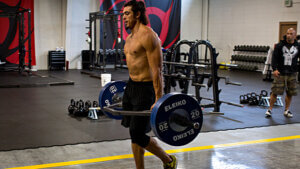
The Farmer’s Walk is a classic physical exercise used by strongmen, as well as athletes looking to improve their strength and energy levels, and boost stamina and muscular endurance.
It will help you on your fitness journey all the way to achieving spectacular fitness goals.
You will see muscle growth, improve performance, develop your core, burn fat, work on grip strength, enhance your balance, and utilize muscles that you never knew existed.
Oh yes. It’s the whole 9-yards.
Regularly working on the Farmer’s walk will have a positive influence on your functional movements outside of the gym as well.
But as they say, it’s only effective when done right.
Here is how to do this exercise correctly
- Place two dumbbells or kettlebells slightly wider than shoulder-width apart.
- Stand in between them.
- With an erect spine and flat back, squat down and grip the weights firmly with an overhand grip.
- Brace the core and squeeze your glutes as you lift the weights up and stand erect with a straight posture
- Look straight ahead
- Walk for the allotted time or the scheduled distance
- Set the weight down gently.
Video Demonstration of The Farmers Walk Exercise
There are numerous ways to use the Farmer’s walk to build your stamina.
You can use heavy weights (think 1.5 times your body weight) for shorter time durations, or, vice-versa to build endurance.
Some athletes do sprints with heavy weights for endurance running exercises. Don’t try this if you’re a new runner though, and don’t stack on maximum weight all at once.
It is recommended that you start light and slowly add weights as you gain the balance, physical ability, and coordination needed to pull it off.
Building Stamina – Exercise / Routine #2 – HIIT
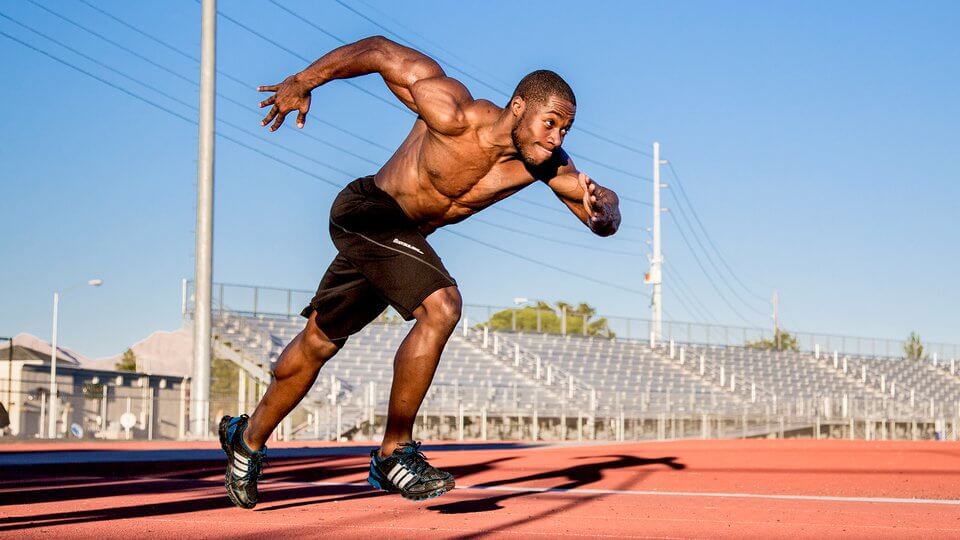
HIIT or High-Intensity Interval Training is one of the most effective ways to build up your stamina, which will eventually improve endurance during hard physical activity.
It trains your heart to pump at max capacity for extended durations of time without getting fatigued.
HIIT involves performing extremely intense workouts, followed by brief low-intensity recovery periods. The actual exercise can be as simple as doing jump ropes or sprinting on the treadmill or biking.
But you have to perform as fast and as intensely as you can for a short duration, like say, 30 seconds or so, after which you’ll rest, or do the same exercise at a much lower intensity for 15 seconds.
This is considered one round of HIIT. Your average HIIT workout can be anywhere from 10-30 minutes and constitute 6-10 rounds.
HIIT improves your metabolic rate, torches body fat for hours afterward, burns a butt load of calories in a very short time, it improves oxygen consumption, something that’s linked to your endurance.
Experts believe that it is the most efficient way of working out.
Endurance Building Exercises
Listed below are exercises designed to help you build and improve your endurance
Building Endurance – Exercise / Routine #1 – Hybrid Muscle Training
Hybrid Muscle Training is a reasonably new training methodology that’s applied by elite athletes looking to develop strength, stamina and endurance. At the same time, it’s perfectly suited for hypertrophy as well.
It combines two exercise routines into one and trains multiple muscle groups at the same time.
While your choices are endless when it comes to combining different training methods, here are some of the best hybrid exercises that will help you build endurance and stamina.
The Jump Pull Up
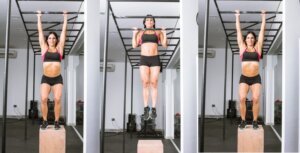
An extremely challenging, dynamic move that fires away multiple specific muscle groups at the same time, the jump pull-up is a CrossFit staple.
You stand below a pull-up bar with your knees bent and under the hips. Then you jump up to the bar driving your feet into the ground for momentum, almost like a spring recoiling.
Now’s the fun part.
You grab the bar and use the momentum from the jump to pull your chest upwards to the bar and slowly come back to the ground or the box.
You use your entire core (the more core strength you have the better), your arms (biceps & triceps), lats (upper and lower lats), your back, and all major muscles in the lower body.
Thrusters

Thrusters are a combination of a front squat and the overhead press, two compound movements that involve major muscle groups of the upper and lower body.
It is primarily used in Olympic training. But the sudden transition from a front squat to the overhead press helps build great control, and balance and will improve your functional movements.
If performed as a HIIT move with lighter weights, it will also rev up your heart rate (Endurance) while helping you develop both strength and hypertrophy.
You can do these with dumbbells, a barbell, or a kettlebell.
Stand in the classic front squat position resting the weights on your shoulders, push your hips back perform a full front squat, drive your feet into the ground, and push the weights up in an explosive move transitioning into an overhead press.
That’s one rep.
Video Demonstration of Thrusters
Building Endurance – Exercise #2 – Use a Non-Linear Periodization Routine
Non-Linear Periodization is one of the best training methods to build endurance as discovered lately by coaches and athletes.
It is based on the SAID (Specific Adaptation to Imposed Demands) principle, which states that your body will eventually adapt to a linear periodization program.
This means that you either have to use an overload principle or use a non-linear periodization routine to break through plateaus.
As implied by the name, it uses a Non-Linear progression where weights, reps, intensity and volume are alternated in small cycles called ‘Micro Cycles’. Each Micro Cycle can last a week or more.
During each cycle, you will alternate between light, moderate, heavy, and power days.
Lightweight days will be about using light weights targeting the 15-20 rep range that improves blood flow, flushes out waste from muscle tissue, and reduces soreness.
On moderate weight days, you will work on hypertrophy by focussing on the 10-12-rep range that increases sarcoplasm and non-contractile proteins.
In a nutshell, this is the classic bodybuilding training where you mix compound moves with isolation moves. If you hate limiting your workouts to compound moves alone and are yearning to hit your arms, this is where it fits in.
Heavy and Very Heavy days are what help to trigger myofibrillar hypertrophy. You can alternate between 4-6 reps and 1-3 reps with your weights.
Not only does going extra heavy help build muscle strength, but you will also neutrally recruit more muscle fiber and trigger myofibrillar hypertrophy.
These days will strictly be limited to complex, compound moves.
Power days are about recruiting explosive speed into complex moves. Somewhat like the hybrid moves that we mentioned earlier.
You can use 30-60% of your 1 Rep Max and perform power moves such as clean and jerks, speed benches, squats and deadlifts, snatches, and weighted plyometric exercises.
The distribution of the days in each micro cycle will depend on your goal.
If someone’s goal is to purely build endurance, there will be more power days and very heavy days, as opposed to someone whose goal is muscular hypertrophy, who will incorporate more moderate and light days into the program.
And while at it…
One more thing to keep in mind when shooting to continue improving your stamina endurance or overall body’s physical capability & well-being is maintaining a balanced diet and hydration (very important to stay hydrated).
Lean protein, carbs, fruits and veggies, and healthy fats make for an essential determining factor in muscle growth.
This means significant improvements in your ability to sustain strength to enable you to crush workouts harder and good stamina for both athletic performance and other activities like daily tasks.
You will also feel energetic and perform at near maximum capacity, if not your full max.
The Importance of Stamina and Endurance
Building stamina and endurance make you a better athlete. But more importantly, it primes your body for better performance in everyday life.
You will feel more active, you will utilize oxygen better, and you will be more flexible, leaner, and fitter.
But it’s equally important to build both muscle endurance and cardiopulmonary endurance to have better, all-around fitness.
If you work on cardiopulmonary endurance alone, for example, then you will not be able to strength train for an extended period of time. Similarly, if you work on muscle endurance alone, then you will miss out on improving cardiovascular endurance strength for overall physical fitness.
Again, remember that progress takes time, sometimes a long time, so take it easy and build yourself up.
Recommended Reading;
- Is Running After Leg Day Okay?
- Biceps VS Triceps
- Caffeine Anhydrous – What is It?
- Beta-Alanine Free Pre-Workout
- I Did 100 Kettlebell Swings a Day… And Here’s Why You Should Do it, too!
- Jumping Jacks vs Jump Rope: Which Is Better?
Sources:
Ben Mayz
Hi there! I'm Ben, main author and chief editor at Fitlifefanatics.com. I have been obsessed with Strength Training and Fitness for 18 years now.
My passion for living a happy fit lifestyle is what made me realize that fitness is what I wanted for my future.
I went on to earn my Masters in Sports Training & Biomechanics.
My passion for Strength training & fitness and my love of helping others is what made me start Fitlifefanatics.
Here, myself, and a team of specialist aim to provide the most accurate, and actionable information possible in hopes to help foster the fitness community forward.
You can learn more about Fitlifefanatics on our About Page

